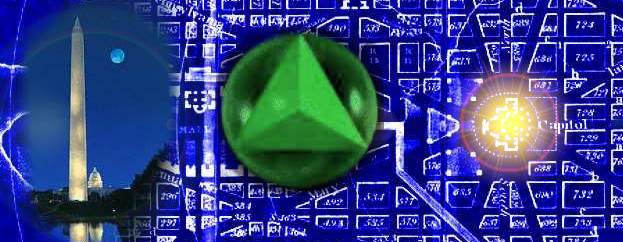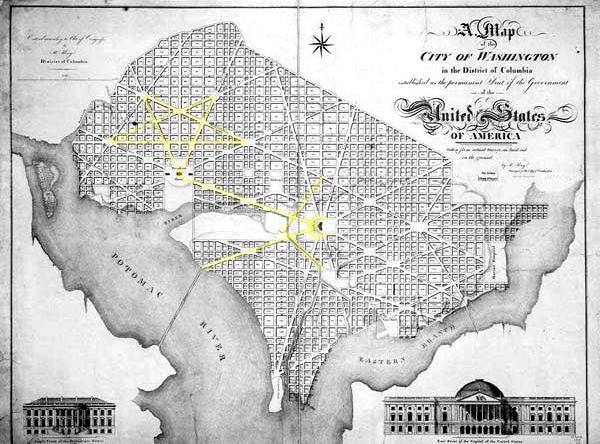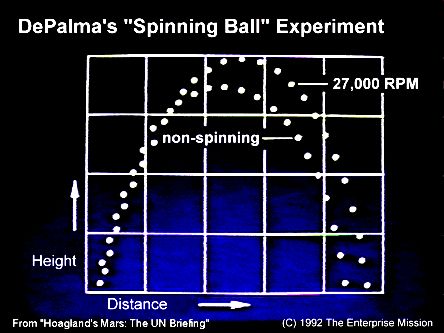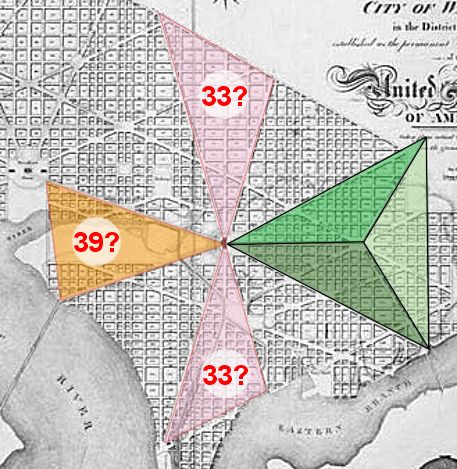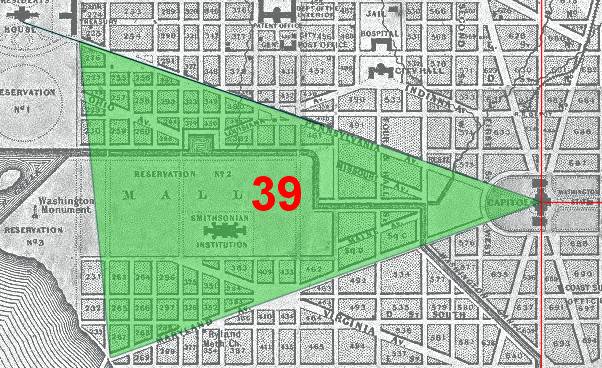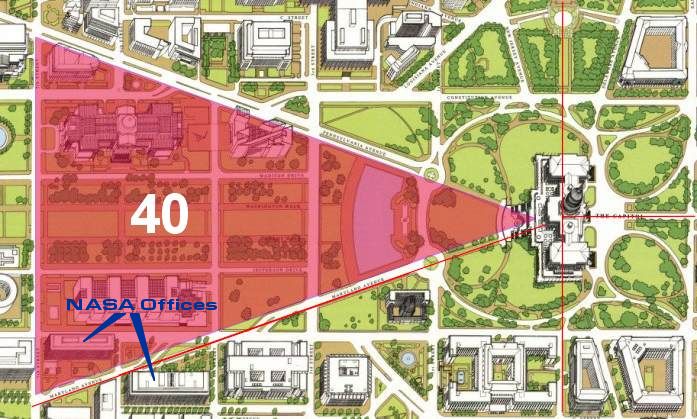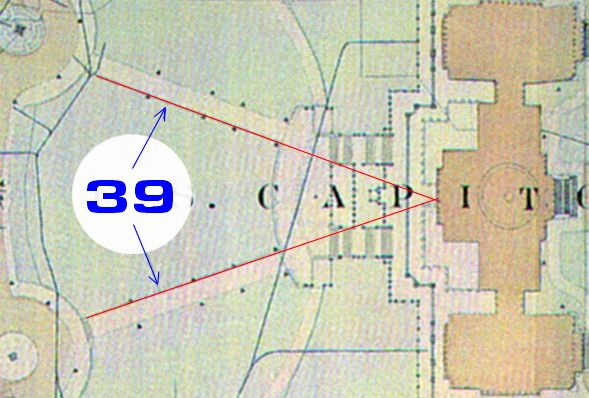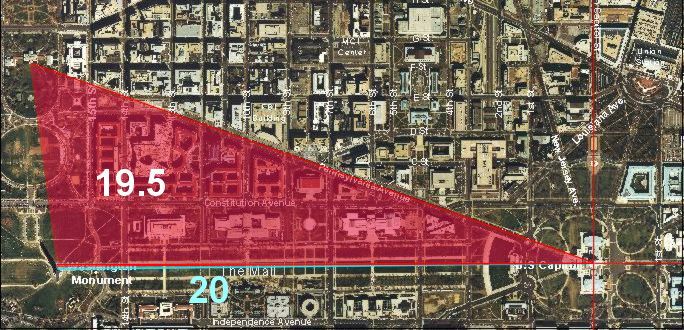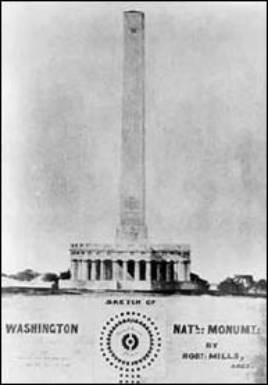| The Conspiracy
The Tetrahedral World of Washington D.C. c
c Part One
Introduction An earlier Cydonia Quest article examined the Enterprise Mission's claims that someone at NASA is attempting to arrange space missions around an unusual form of electional astrology using tetrahedral angles and stars associated with the ancient Egyptian cult of Osiris, Isis & Horus. This statistical study of the first 108 space shuttle missions (which can be read by clicking this "stargate" µµµ) found there was indeed an above chance bias towards space shuttles being launched when the specified stars were close to the "tetrahedral" angles of 33 and 19.5 degrees. This study could not prove beyond a reasonable doubt that this bias was deliberate. However, the level of bias was great enough to make this researcher sit up, take notice and explore the issue further.
The assumption made by the Enterprise Mission is that the group concerned in these hypothetical astrological operations is made up of Scottish Rite Freemasons. This assumption is based on the remarkable contribution Freemasons have made to the NASA space programme, the interest of Freemasonry in astrological symbolism, and the traditional obsession of Western esotericism (including Freemasonry) with the wisdom of ancient Egypt. The fact that the highest degree of initiation in Scottish Rite Freemasonry is the 33rd also tends to point to this particular esoteric group in the eyes of the Enterprise Mission.
What has been missing from Cydonia Quest's exploration of the Enterprise Mission's NASA Masonic/Egyptian theory is some evidence to link Freemasonry with tetrahedral geometry. A combination of David Ovason's book The Secret Zodiacs of Washington DC: was the city of stars planned by Masons?, a discussion thread on the Anomalies board and the Enterprise Mission's "Millennium" series made me wonder if one place to look was Pierre Charles L'Enfant's street plan for Washington DC. Both L'Enfant and the patron (George Washington) who made amendments to these plans were Freemasons, (see µµµ & µµµ). |
| C
ccccccccc
C The Washington plan above was originally posted on the Enterprise Mission's own website and shows the famous White House pentagram and the Capitol/Mall compass dividers - these are amongst the most important symbols of Freemasonry. In examining this plan for evidence of tetrahedral geometry something very tetrahedral quickly became apparent. Before examining what this something is, this would be a good juncture to re-familiarise ourselves with the Enterprise Mission's arguments for why 33 and 19.5 degrees are linked to tetrahedral geometry.
The Enterprise Mission theory revolves (literally) around the geometry of a tetrahedron circumscribed within a spinning sphere so that one apex is touching one of the axial poles. Once a sphere is set spinning around an axis we immediately have a point of reference from which to plot latitudes on its surface. Latitude is measured as an angle between the centre of the sphere, its equator and the spot on sphere's surface to be measured. If a circumscribed tetrahedron is attached to a sphere's polar axis in the way described above then the other three apexes will touch the inside of the sphere at a latitude of 19.471 (decimal notation) degrees in the opposing hemisphere, (19.5 is a convenient simplification of this number). This is shown in the Enterprise Mission diagram below. C
ccccccccccccccccccccccc
C The Enterprise Mission's own interest in this form of tetrahedral geometry is based on their own belief that spinning bodies/systems (such as planets) are somehow able to draw upon energy from physical dimensions beyond our perceivable three dimensional space. This proposed energy effect is proportional to angular momentum so that it can be measured in even a small body if it rotates fast enough. The experiments of the late Dr. Bruce DePalma seem to confirm this rotational energy anomaly. The Enterprise Mission have observed that in large, slowly rotating bodies - planets and stars - there is a very frequent energy "hot spot" to be seen on the surface at the 19.471 latitude. They propose that the hyperdimensional energy freed by rotation is guided into three dimensional space through tetrahedral geometry. |
|
In a universe where everything seems to work in curves this idea of a physical effect manifesting itself through a rigid straight line geometry appears very strange. However, recent mapping of the distribution of galactic super-clusters has revealed that they are arranged around the edges of a honeycomb of another regular Platonic solid, the octahedra (see µµµ), which is equally as strange. In this context we may note that the geometrist Buckminster Fuller observed that the true geometry of the Universe was logically tetrahedral and that all other stable geometries such as the octahedra could be collapsed into the tetrahedron, (see µµµ, µµµ & µµµ). This is not the place to dwell long on the Enterprise Mission's theories on hyperdimensional physics. More can be read about them by clicking these "stargates" µµµ & µµµ. c
ccccccccccccccccc
c As for the significance of the number 33 the Enterprise Mission have this to say.
"As we have noted before, engineer and probabilities expert Mary Anne Weaver has pointed out that one of the basic trigonometric functions of a circumscribed tetrahedron, the sine of 19.471 -- the key "circumscribed tetrahedral angle" at Cydonia -- is .3333. That in of itself would be merely "interesting" if it were the only mathematical link between 19.5 and 33, but there is another, more significant link.
A tetrahedron is one of the so-called "Platonic solids," so named because the Greek mathematician Plato was one of the first to popularize them (although, like some modern "science popularizers," he actually "borrowed" them from the earlier insights of another genius Greek geometer, Pythagoras). Each of these Platonic solids (there are only five) is characterized by the fact that they are all "regular" polyhedra, polyhedrons that have regular polygonal faces, or faces with a straight-sided figure with equal sides and equal angles. In other words, they will all fit neatly in a sphere -- with no edges or angles protruding through the surface. Of these, the simplest, and therefore the "first" among them, is our old friend the "tetrahedron."
Each of these Platonic solids is commonly identified among mathematicians with the notation {p, q}, where p is the number of sides in each face and q is the number of faces that meet at each vertex. The tetrahedron has 3 sides on each face and has 3 faces that meet at each vertex. As a result, its nodal designation in this system would be {3,3}. Or, obviously, "33."
By simply taking out the comma, we can see that every bit as much as the ubiquitous "19.5," the number "33" says; "look to your tetrahedrons!" It's just a little less obvious, a little harder to figure out, a little more coded."
Now that the basics of the Enterprise Mission's specific tetrahedral geometry have been covered the following may make more sense to the reader. C The Radiant Tetrahedron of Capitol Hill
In the L'Enfant plan for Washington the Capitol building was intended to be the spiritual heart of the city with avenues radiating in almost every direction from it. This takes on even more significance when it is realised that the Capitol is at one apex of a three dimensional representation of a tetrahedron formed out of L'Enfant's street plan. The base of this tetrahedral pyramid is made up of the eastward extensions of Maryland Avenue, Pennsylvania Avenue and 17th Street. The ridge lines of this tetrahedral depiction are made up of East Capitol Street, Tennessee Avenue and Kentucky Avenue. These converge at an apex at Lincoln Park. Although the tetrahedron is being represented as if viewed directly from above, it is also true to say that it is being viewed along one of the axis around which it could be symmetrically rotated. (Although the north-east corner of the tetrahedron lies outside the boundary road in the plan this is not unusual for the bigger pentagrams in L'Enfant's design. The man obviously "thought outside the box"). C ccccccccccccccccccc
C This tetrahedron depiction was interesting in itself, but there was also the small point of the "beams" it was shining out from its tip in the centre of the Capitol building. After enlarging and printing out the relevant part of the map on the Enterprise Mission website it was determined that the south and north beams (made out of the intersection of New Jersey and Delaware Avenues) were radiating at an angle of 33 degrees - which was of obvious significance for their theories. The west beam was made by drawing lines from the centre of the Capitol to the Potomac end of Maryland Avenue and the White House end of Pennsylvania Avenue. This was measured as having a diverging angle of 39 degrees. Now 39 is equal to 2 x 19.5 and there is certainly some logic in seeing the western beam as two 19.5 degree angles being mirrored either side of the Mall. If there had been a West Capitol Street the west beam would have indeed been split into two 19.5 angles.
However, this was just one small map of the L'Enfant plan. So several larger scale versions were downloaded from the internet. Also downloaded were some maps of modern Washington DC together with aerial and satellite imagery. For good measure a modern street map on paper of the city was also purchased.
The first thing that has to be realised about the maps from the late 18th and early 19th centuries is that they show a plan of the city and not an actual city. (Washington was mostly fields, swamps and woods well into the 19th century). The street plans don't show actual streets, but plots of building land with spaces left in between where the streets would fit in one day. Therefore, there aren't any nice straight lines depicting roads to measure. Instead this Cydonia Quest study drew lines along the edges of the plots on both sides of the "streets" to gauge what the underlying geometry of the plan was. Given the vagueness of the plan several different old maps were compared to cross check conclusions. Readers can find a selection of early maps of Washington at the ends of these "stargates" µµµ, µµµ & µµµ.
It should be noted that all diagrams in this article have been crudely drawn with a computer mouse and are for illustrative purposes only. The diagrams may not exactly match up with the lines drawn on the printed maps from which the conclusions were drawn.
The North & South Beams. Maps examined for the period between 1792 and the 1830's confirmed that the intersection cross-over between New Jersey and Delaware Avenues was planned around a 33 degree angle. However, later on in the 19th century when the actual roads were fixed in place this angle had shrunk to 32 degrees. Although Delaware and New Jersey Avenues have been almost obliterated by modern developments there is still enough left in modern street maps to see this today, (see µµµ). The reasons why this angle might have been reduced to 32 degrees will be discussed a little further on. Even more strange is that L'Enfant's draft of 1791 shows an intersection angle of 30 degrees. The possible alternative tetrahedral geometry in this draft plan will be explored in Part Two.
The West Beam. Old maps of Washington did confirm that the angle between the specified ends of Maryland Avenue, Pennsylvania Avenue and the centre of the Capitol was 39 degrees, as shown in the first diagram below. (This particular map is from 1862 in which the south and north beams have already been reduced to 32 degrees). However, the discerning reader will realise that the lines so created don't exactly follow the courses of Pennsylvania and Maryland Avenues. This is because the western sections of these avenues do not actually cross- over in the centre of the Capitol building like other avenues and streets, but instead cross-over in the front part of the building. This small relocation to the west is enough to widen the angle of divergence between these avenues to 40 degrees as shown in the second diagram taken from a modern map. C cccccccc
cc
c Note: the modern map above gives some idea of the level of destruction of Maryland, New Jersey and Delaware Avenues by modern developments. The Capitol building in this map is depicted in distorting 3-D. The actual centre of the building is marked by the intersection lines of East, North and South Capitol Streets, which have been marked out with red lines. By the time the lines of Maryland and Pennsylvania Avenues have reached this point they have already completed their cross-over.
The 40 degree angle of divergence between Pennsylvania and Maryland Avenues may provide a possible Masonic explanation for why the angles for the north and south beams were narrowed to 32 degrees from 33 degrees. David Ovason's book depicts a fine picture of 19th Century Washington as a Masonic hotbed. If Freemasonry continued to guide the street plan of Washington and the number 39 did hold a special significance for the "Craft", then we may be witnessing an insiders' number game. If the angle between Pennsylvania and Maryland Avenues was one degree too great for "perfection" then balance could be maintained by ensuring that the intersection angle between Delaware and New Jersey Avenues was made one degree "too small". Those in on the secret would know that a degree should be taken away from one angle to be added to the other to achieve the desired result.
We are therefore left with some ambiguity as to whether the 39 degree angle that fans out as the west beam from the Capitol building was actually intended or not. It is certainly the case that the early plans allowed enough space for manoeuvre west of the Capitol for Pennsylvania and Maryland Avenues to begin diverging at 39 degrees and then widen to 40 degrees. L'Enfant's draft plan of 1791 suggests that both 39 and 40 degrees might have held significance - and remembering that these beams are radiating from the tip of a tetrahedron, significance in terms of tetrahedral geometry.
Update 20th July 2003 - To make matters even more interesting the Enterprise Mission have long claimed that the divergence angle between Pennsylvania and Maryland Avenues within the grounds of the Capitol starts out at 39 degrees. Cydonia Quest has now been able to confirm this using a map from G.M. Hopkins' Atlas of Washington DC published in 1887. This new information is shown in the illustration below. So the divergence angle between the avenues starts out at 39 degrees for only a short distance before switching to 40 degrees. c cccccccccc
C A Speculation About the Federal Triangle. Those who have read David Ovason's book will know that he is convinced that there is some special significance in the angle between the Capitol, the White House and the Washington Monument. When L'Enfant drafted his original plans these were the only edifices marked in the maps. (Although it should be noted that the monument to the Republic, quickly changed by a grateful Congress to a monument to honour George Washington, was only intended to be a modest affair). All of these structures had public Masonic corner stone laying ceremonies that were reported in the local newspapers of those days. Ovason believes that the triangle (the Federal Triangle) between these three structures may have been meant to represent the triangle of bright stars Spica, Regulus and Arcturus that surround the constellation Virgo. In symbolic astrology Virgo is linked with the Virgin Mary and the Egyptian goddess Isis - the latter to whom Ovason believes Washington DC was symbolically dedicated to in the ancient manner.
However, given the 39 degree angle of the western beam it is worth exploring whether there is a 19.5 degree angle sandwiched between the north base of the Washington Monument, the south bay of the White House, and radiating from the centre of the Capitol. The justification for using the edges of the White House and Washington Monument is based on the observation that the tip of the White House pentagram converges on the edge of that building's north portico and that the line of Pennsylvania Avenue (coming up from the Capitol) is aimed straight at the middle of its south bay. These edge alignments seem to be the result of careful design. C
ccc
C As the aerial photo above illustrates the resulting angle is actually closer to 20 degrees rather than 19.5 degrees - although this is not the end of the story. To see why we should consider the history of the monument. Congress were so tardy in following through their decision to build a monument to George Washington that in 1833 a Washington Monument Society was formed by concerned citizens to do the job for them. The design chosen was by the architect Robert Mills and consisted of a 600 foot high obelisk surrounded at the base by a circular colonnade. This colonnade, which marked the true edge of the monument, was quickly abandoned for lack of money after the cornerstone was laid in 1848. Soon afterwards lack of money and sectarian politics led to the monument being abandoned for twenty years as a 150 foot high unfinished stump. Eventually Congress was lobbied into honouring its promises and the stump was pulled down and an entirely new 555 foot obelisk was built on the same foundations. This had its public Masonic dedication ceremony in 1885. C ccccccccccccccccccccccccccccccc
c Robert Mills' original design for the Washington Monument can be seen above. (An even earlier idea was to put a statue of George Washington depicted as the Sun god Apollo riding his Sun chariot on the pinnacle). Today the outer edge of Mills' intended colonnade seems to be marked by a circle of flag poles and paved landscaping. If we assume that the north face of the colonnade was meant to be the edge of the Washington Monument then the angle between this, the south bay of the White House and lines radiating from under the dome of the Capitol building is indeed 19.5 degrees. (The difference between the "intended" 19.5 degree angle and the 20 degree angle resulting from the thinner monument that actually got built is shown in the illustration).............
.........Oh yes, Robert Mills was initiated into Freemasonry in 1814 so that 19.5 degree angle may indeed hold some significance for the "Craft", (see µµµ)
In Part Two of this series of articles Cydonia Quest will explore the tetrahedral geometry that seems inherent in L'Enfant's 1791 draft plan. Part Two will also look at some of the other imagery in the street plan east of the Capitol such as the hexagram. It will also look at the White House hexagram and tetrahedron.
Part Three will consider the three dimensional significance of the two dimensional hexagram to Freemasonry.
Part Four will consider the surprising number of pentagrams in the L'Enfant plan for Washington, then move on to the surprising geometrical link between the two dimensional pentagram and the three dimensional tetrahedron in four dimensional geometry.
µ Click "Stargate" to Proceed to Part Two c
µ Return to The Conspiracy Latest Developments µ Click "stargate" to return to The Conspiracy Part Three µ Return to the Cydonia Quest main page |
